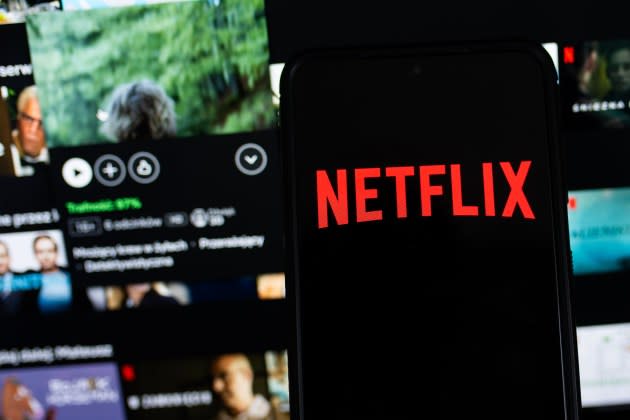Netflix Reveals Viewing Data For First Time Across Its Entire Catalog

So much for the black box.
Netflix today has revealed viewership data for 99% of its entire catalog, or more than 18,000 titles available around the world. It published the numbers in a report, What We Watched, capturing viewing from January to June of 2023. It is the first edition of a planned semi-annual look at viewership. The initiative aims to document the the full picture instead of the existing glimpses of only the top-performing programming. The company pointed out that its existing Top 10 lists have a large degree of overlap with the full data, with 60% of the titles in the first-half study having made appearances in the Top 10 at some point.
More from Deadline
Netflix Data Dump Reveals Eclectic List Of Top UK Originals, With 'Luther' Leading The Pack
South Korean TV Phenomenon Goes Way Beyond 'Squid Game', Netflix Viewing Data Reveals
“This is a big step forward for Netflix and our industry,” the company wrote in a blog post. “We believe the viewing information in this report — combined with our weekly Top 10 and Most Popular lists — will give creators and our industry deeper insights into our audiences, and what resonates with them.”
Hollywood guilds had long objected to the lack of transparency in streaming data and WGA and SAG-AFTRA both made the issue a key bargaining point in this year’s dual strikes. The oft-used metaphor was that the data was locked away in a “black box,” accessible mainly to the company looking to mine it for ways of increasing subscriber rolls and profitability. Netflix, which has volunteered significantly more information than any of its streaming peers, started publishing its weekly Top-10 lists in 2021. Its titles are also represented in Nielsen’s weekly snapshots.
During a 30-minute media conference call, Co-CEO Ted Sarandos reflected on the evolution of Netflix during its push into streaming over the past decade and a half. For many years, he and other executives had come under intense criticism for operating in secrecy. “The unintended consequence of not having more transparent data about our engagement was that it created an atmosphere of mistrust over time with producers and creators and the press about what was happening on Netflix,” he said. The effort to reveal more comprehensive numbers, he said, is “on the continuum of transparency as streaming becomes more and more mainstream. It’s more on par with other parts of media that have quite accessible information about how things are performing.”
While the company’s recent entry into the advertising business has been a major corporate initiative, the release of the data was not motivated by an effort to appease ad buyers, Sarandos said. Marketers have always looked for numbers verified by third parties such as Nielsen, he noted.
In the blog post, the company said the new report will include any title, original or licensed, that was watched for at least 50,000 hours in the six-month period. Subscribers, though, gravitate toward hits, giving the full data set a lot of points in common with the weekly charts. “This report closely mirrors our Top 10 list,” Lauren Smith, VP of Strategy and Analysis said during the press call. “While it is broader in scope, you’ll find familiar trends.”
There is an important methodology change from the Top 10, however. Data in the new report is expressed in terms of hours viewed, which is no longer the metric that Netflix uses to rank its own Top 10 and Most Popular lists. Since June, Netflix has reported “views,” which it calculates as hours viewed divided by runtime. Since then, both the WGA and SAG-AFTRA have adopted that calculation in regard to streaming transparency and performance bonuses in their latest contracts with the studios.
One of the biggest issues with measuring in hours viewed is that it favors content with a longer runtime, which generally are drama series. Films are at an even higher disadvantage. Much like “views,” reporting data in hours viewed also gives no insight into how many accounts completed a title, or even engaged with it past the first episode. This is a value piece of data that all streamers, especially Netflix, use to determine the success of their content.
The top-ranking title in the new report was The Night Agent, with 812.1 million hours of viewing. It was among several new series to chart, along with The Diplomat, Beef, The Glory, Alpha Males, FUBAR and Fake Profile. Familiar originals also fared well, among them Ginny & Georgia, Alice in Borderland, The Marked Heart, Outer Banks, You, Queen Charlotte: A Bridgerton Story, XO Kitty and film sequels Murder Mystery 2 and Extraction 2.
Sarandos was asked about the significant percentage of viewing (45% of the total) accounted for by licensed fare in the report. The dominance of Suits in 2023 has become a major storyline for Netflix, with Sarandos declaring at a Wall Street conference last week that the rise of licensing opportunities as rivals pull back on originals is “the more natural state of the business.”
As far as the viewing report for the first half of this year, he said, “We don’t really have a formula for how much it should and shouldn’t be. We’re trying to entertain our members around the world.” Netflix’s original productions have ramped up over the past decade, he added, compared with several times that timespan for traditional media companies now taking part in streaming. Originals will remain important to “thrilling our members,” Sarandos said, and distinguishing the company’s brand, which in turn lowers churn and increases engagement.
Katie Campione contributed to this report.
Best of Deadline
2023 Premiere Dates For New & Returning Series On Broadcast, Cable & Streaming
2023-24 Awards Season Calendar - Dates For Oscars, Emmys, Grammys, Tonys, Guilds & More
Sign up for Deadline's Newsletter. For the latest news, follow us on Facebook, Twitter, and Instagram.

 Yahoo News
Yahoo News 